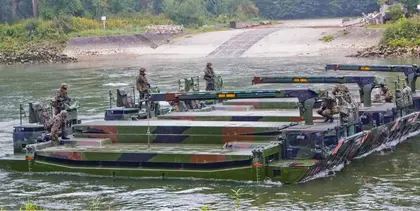It is estimated that there are more than 16,000 road bridges in Ukraine, which range from little more than culverts to widespan bridges such as the 9.1-kilometer New Zaporizhzhia Dnipro Bridge. To date almost 350 significant road bridges and overpasses have been destroyed.
Many of these bridges crossed rivers, so Ukraine’s ability to cross them could dictate the pace of its future advance. The Russians know this and have relied on the obstacle presented by the Dnipro River to protect the flanks of their defensive lines.
The width of the river ranges from 200 to 1,200 meters and Moscow’s troops have focused much effort on destroying bridges to interdict Ukrainian movement and to channel Kyiv’s forces against the lines of minefields, trenches, tank traps and other obstacles they have prepared.
As Ukraine has attacked these lines and begun to make advances, albeit small ones, in the Donetsk, Luhansk and western Zaporizhzhia sectors of the front line, Russia has been forced to move highly capable airborne troops (VDV) from the south, specifically in the areas around Kherson. This may give Kyiv an opportunity to exploit, and recent reports suggest that may be exactly what they are doing.
Social media has shown that British-trained Ukrainian amphibious combat troops have established two small bridgeheads close to Antonivsky Bridge, south of Kherson city and Kozachi Laheri on the left bank of the occupied part of Kherson region.

ISW Russian Offensive Campaign Assessment, July 24, 2024
Uncorroborated reports suggest attempts are being made to establish a third bridgehead at Hola Prystan, west of the Antonivsky Bridge. If reinforced, these footholds have the potential to provide crossing points, move a formidable force across the Dnipro River, bypass the so-called Surovikin line, and strike towards the road and rail links to Crimea.
However, the Dnipro River, along with its tributaries and wetlands, present substantial obstacles in themselves; although perversely, the destruction of the Kakhovka Dam by Russia may have reduced the challenge to making crossings in the area.
What assets does Ukraine have to cross water obstacles?
The Armed Forces of Ukraine (AFU), like any modern army, already had bridging equipment before Russia’s full-scale invasion, but a lot of it has already been used to temporarily replace or repair destroyed bridges.
In the lead-up to the counteroffensive, their capacities have been reinforced by engineering equipment provided as both military and humanitarian aid by Kyiv’s partners. While much of this has been utilized to compensate for the loss of bridges for both military and civilian traffic destroyed in the war, there is likely to still be sufficient resources to allow effective progress.
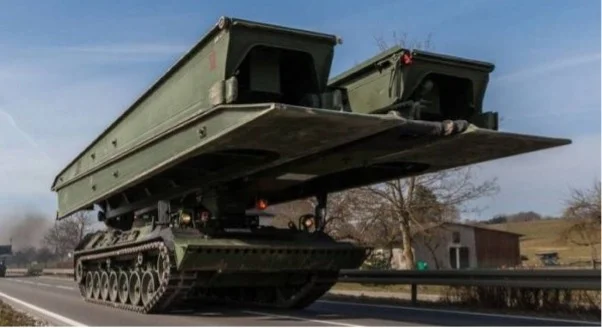
Biber bridge-laying armored vehicle. Photo: German MoD
Medium armored bridge-layers
Ukraine has received a number of these equipment, such as the “Biber (Beaver)” bridge-laying tank of which more than 20 have been provided by Germany and Denmark and the US M6 bridge-layer.
Biber is based on the chassis of the Leopard 1 tank and carries a 22-meter-long by 4-meter-wide, rapidly deployable assault bridge that can be positioned in 2 to 3 minutes. The bridge can support armored vehicles up to 60 tons in weight.
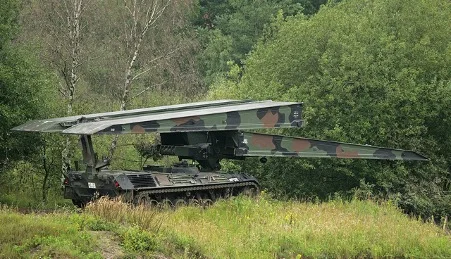
Biber bridge-laying armored vehicle. Photo: German MoD
Medium girder bridge
The International Fund for Ukraine (IFU) has purchased an unspecified number of Medium Girder Bridges (MGB) which provide a span of 9 to 31 meters with a minimum load capacity of 70 tons. These are aluminum bridges for which a single span can be laid by 15 to 20 engineering personnel in as few as 10 to 15 minutes.
Pontoon bridges
A pontoon or floating bridge is a continuous deck that is held in place by a number of floats, shallow-draft boats or specialized amphibious vehicles to provide a crossing point. The number of “floats” and their buoyancy governs both the span of the crossing and the maximum load that they can carry.
If the bridge is based on amphibious vehicles, then it can also act as a “ferry” if the span is insufficient. The Netherlands has supplied six M3 Amphibious Rig bridging vehicles which will allow a span of 40 meters or use as vehicle ferries.
These will supplement the existing KrAZ-255 PMP floating pontoon bridges held by Ukraine which are used to support a deck crossing.
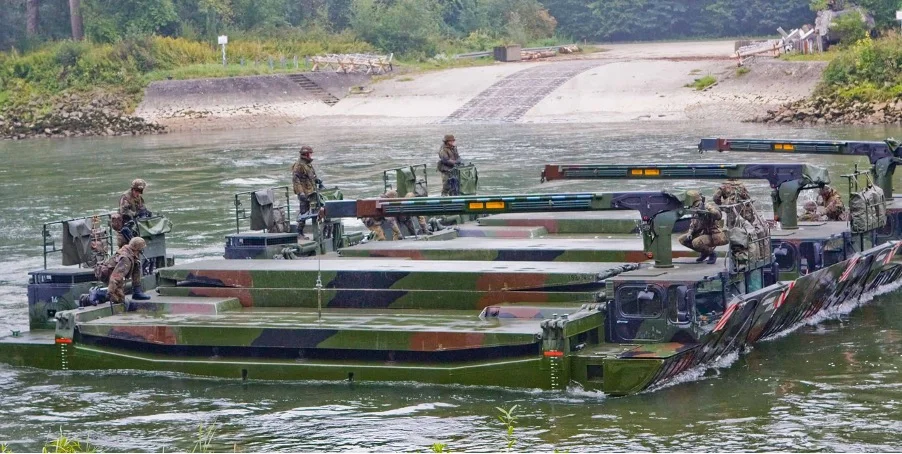
Netherlands M3 amphibious rig. Photo: wikicommons
Motorized floating bridge (MFB)
The MFB differs from other bridge layers in that it is a combined pontoon bridge and amphibious vehicle which allows more rapid redeployment of the bridge structure and an additional use as a ferry.
Multiple MFBs can be linked together to create a traditional pontoon bridge. France has supplied an unspecified number of its PFM (pont flottant motorisé) systems.
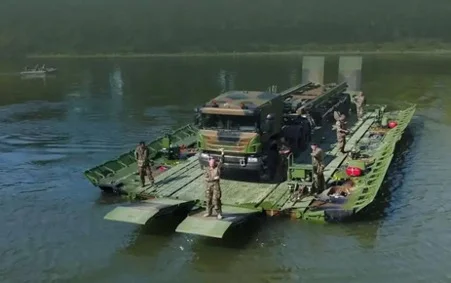
French PFM motorized floating bridge used as a ferry. Photo: CNIM (manufacturer)
River crossing in contact with the enemy
The bridgeheads seized close to Kherson present an opportunity to by-pass Russia’s extensive main fortifications and foreshorten the advance on Crimea. However, it must be borne in mind that forcing a river crossing while in contact with the enemy is considered to be one of the most highly complex military operations and not without risk – especially as, in every phase of this war, Ukraine lacks even localized air superiority.
River crossings against a determined enemy are one of the most difficult combined arms operations possible. The US Army manual for conducting such activity, FM 90-13/FMFM 7-26, is over 130 pages long. One of the major impediments to success is control – to ensure that forces arrive at the crossing points in a controlled manner, at the right time and can move quickly to minimize the time when they are vulnerable.
The US manual breaks down river crossing operations into five phases:
Phase 1 – advance to the river
The first task is to secure the nearside crossing point, the embarkation point for the bridge, pontoon or ferry. Simultaneously every available asset, artillery, helicopters, drones, and close air support (if available) should be employed to suppress the enemy on the far shore and exit bank. If possible other forces should be used to distract the enemy focus through diversionary attacks elsewhere – in this particular case that is already happening by virtue of the attacks on the Surovikin line.
Phase 2 - assault across the river
The exit point on the enemy side of the river needs to be secured. This seems to have been partially achieved already at the three bridgehead sites but it will be essential that these, or at least those that are selected to act as the crossing point(s), are reinforced as soon as possible and the enemy is continually suppressed by both direct and artillery indirect fire supplemented by the use of smoke and electronic means to obscure the crossing site and unit maneuvers. Simultaneously suppressing fire should continue on enemy formations that can threaten or reinforce its defense of the exit-bank and bridgehead objectives.
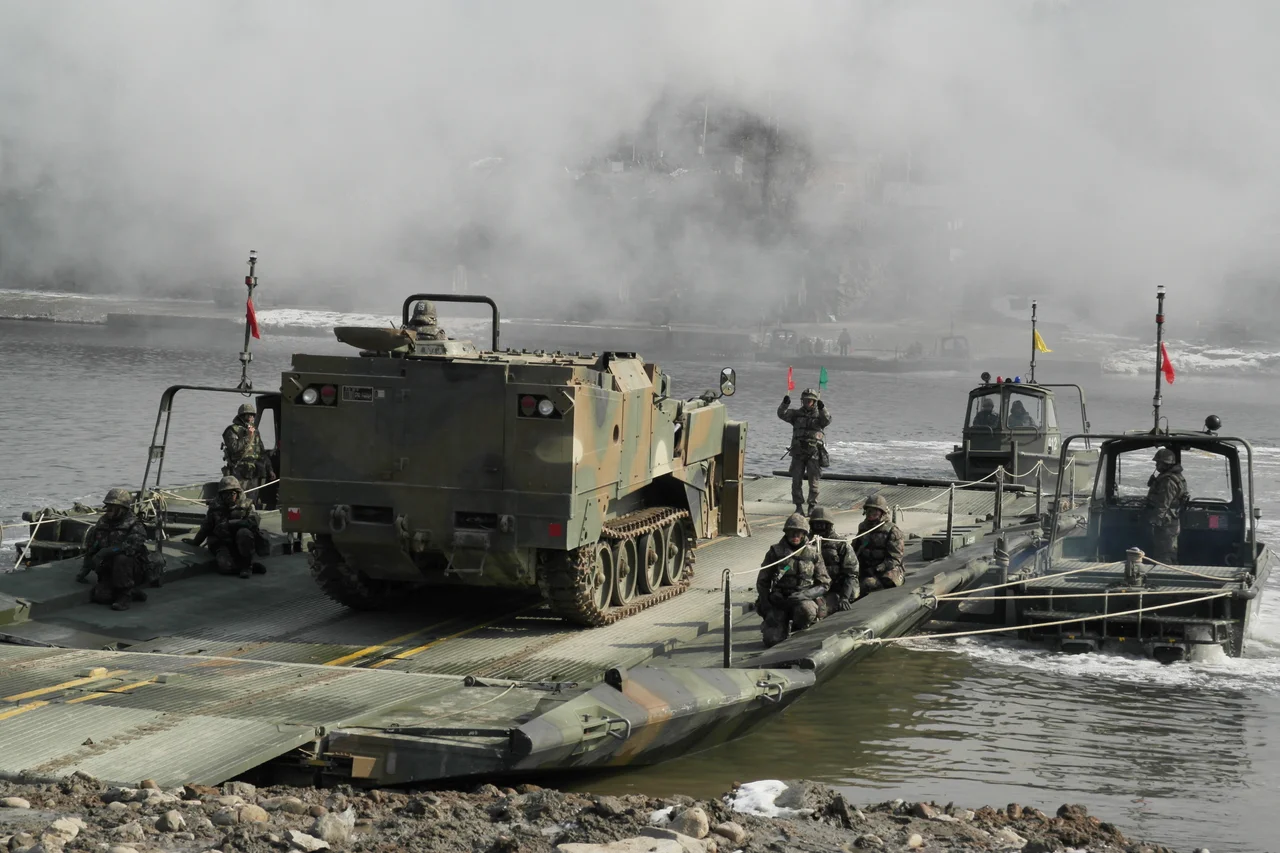
South Korean forces using pontoons. PHOTO: Wikicommons
Phase 3 - advance from exit point
This phase includes construction of the bridge across the river or rapid deployment of pontoons and/or ferries and the initial crossing of all arms groups of infantry, tanks, engineers and artillery to secure the exit bank and eliminate enemy direct and observed indirect fire onto the crossing area. Simultaneously attacks by artillery, helicopters, drones, and close air support against targets on and near the bridgehead and final objectives should continue.
Phase 4 - Secure the Bridgehead
The build-up of friendly combined arms forces continues on the far-shore to secure the bridgehead objectives and to protect the bridgehead against a counterattack. This is aimed at providing the time and space to position the forces necessary to attack out of the bridgehead supported by artillery, helicopters, drones, and close air support against targets at the “final” objective.
Phase 5 - Continue the Attack
It is vital that the river crossing plan “thinks beyond the river.” The crossing is the means to move beyond the obstacle to seize and defeat the enemy at the “final” objective – which in the case of any assault across the Dnipro will merely be the “start line” for the next phase(s) – the move to Crimea.
Conclusion
The Institute for the Study of War (ISW) has suggested that the Russians are increasingly concerned that these Ukrainian bridgeheads could become “semi-lasting positions” and, if they can be exploited, then it will make major Russian logistics lines more vulnerable as well as opening the most direct route to Crimea in an area that is likely to be less fortified than elsewhere along the front.
It should also be borne in mind that an assault across the Dnipro could, in itself, be used as a diversionary to draw in Russian reserves from elsewhere to provoke a vulnerability in other key areas of the counteroffensive.
You can also highlight the text and press Ctrl + Enter


